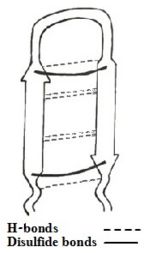Tachyplesin
From Proteopedia
(Difference between revisions)
| Line 22: | Line 22: | ||
== Derivatives or Analogue == | == Derivatives or Analogue == | ||
| - | Among all the existing interactions, the cysteine bridges | + | Among all the existing interactions, the cysteine bridges were considered as the principal contributors of the hairpin loop structure. To test this, three linear derivatives of TP-I (<scene name='67/671725/1ma4/3'>TPY4</scene>, TPF4 and TPA4) were created, in which the bridging cysteine residues were systematically replaced with tyrosine, phenylalanine, and alanine, respectively<ref name=Laederach>PMID:12369825</ref><ref name=Kushibiki>PMID:24389234</ref>. The linear derivatives of TP-I are mentioned below: |
[[Image:Seq TPI.jpg|750px]] | [[Image:Seq TPI.jpg|750px]] | ||
| - | Of | + | Of these 3 linear derivatives of TP-I, NMR structural investigations had shown that TPA4 was unstructured in solution. Also, TPA4 was inactive in terms of antimicrobial activity. In contrast, TPY4 and TPF4 adapt hairpin loop structure and also retain their antimicrobial properties, typical to TP-I. Therefore, the hairpin properties of the peptide seems to be important for recognition of LPS and its biological activities. |
Besides replacement of cysteines, deletions was also performed in TP-I which yielded the surprising result of a hairpin loop that was seen, by NMR structure in LPS, in the <scene name='67/671725/Cdt/1'>Cysteine Deleted Tachyplesin</scene> (CDT). Thus, CTD with sequence NH₂-Lys-Trp-Phe-Arg-Val-Tyr-Arg-Gly-Ile-Tyr-Arg-Arg-Arg-CONH₂ did not have disulphide linkage, but was found to have broad spectrum of bactericidal activity. Specifically, CDT has been demonstrated to markedly inhibit the growth of [http://en.wikipedia.org/wiki/Escherichia_coli <i>Escherichia coli</i>] and [http://en.wikipedia.org/wiki/Listeria_monocytogenes <i>Listeria monocytogenes</i>] akin to TP-I, even with lower minimum inhibitory concentration (MIC) values. | Besides replacement of cysteines, deletions was also performed in TP-I which yielded the surprising result of a hairpin loop that was seen, by NMR structure in LPS, in the <scene name='67/671725/Cdt/1'>Cysteine Deleted Tachyplesin</scene> (CDT). Thus, CTD with sequence NH₂-Lys-Trp-Phe-Arg-Val-Tyr-Arg-Gly-Ile-Tyr-Arg-Arg-Arg-CONH₂ did not have disulphide linkage, but was found to have broad spectrum of bactericidal activity. Specifically, CDT has been demonstrated to markedly inhibit the growth of [http://en.wikipedia.org/wiki/Escherichia_coli <i>Escherichia coli</i>] and [http://en.wikipedia.org/wiki/Listeria_monocytogenes <i>Listeria monocytogenes</i>] akin to TP-I, even with lower minimum inhibitory concentration (MIC) values. | ||
Revision as of 06:22, 26 January 2015
| |||||||||||
References
- ↑ 1.0 1.1 1.2 1.3 1.4 Laederach A, Andreotti AH, Fulton DB. Solution and micelle-bound structures of tachyplesin I and its active aromatic linear derivatives. Biochemistry. 2002 Oct 15;41(41):12359-68. PMID:12369825
- ↑ 2.0 2.1 Chen, Yixin, et al. "RGD-Tachyplesin inhibits tumor growth." Cancer research 61.6 (2001): 2434-2438.
- ↑ 3.0 3.1 Saravanan R, Mohanram H, Joshi M, Domadia PN, Torres J, Ruedl C, Bhattacharjya S. Structure, activity and interactions of the cysteine deleted analog of tachyplesin-1 with lipopolysaccharide micelle: Mechanistic insights into outer-membrane permeabilization and endotoxin neutralization. Biochim Biophys Acta. 2012 Mar 23;1818(7):1613-1624. PMID:22464970 doi:10.1016/j.bbamem.2012.03.015
- ↑ Nakamura, Takanori, et al. "Tachyplesin, a class of antimicrobial peptide from the hemocytes of the horseshoe crab (Tachypleus tridentatus). Isolation and chemical structure." Journal of Biological Chemistry 263.32 (1988): 16709-16713
- ↑ 5.0 5.1 Kushibiki T, Kamiya M, Aizawa T, Kumaki Y, Kikukawa T, Mizuguchi M, Demura M, Kawabata SI, Kawano K. Interaction between tachyplesin I, an antimicrobial peptide derived from horseshoe crab, and lipopolysaccharide. Biochim Biophys Acta. 2014 Jan 2;1844(3):527-534. doi:, 10.1016/j.bbapap.2013.12.017. PMID:24389234 doi:http://dx.doi.org/10.1016/j.bbapap.2013.12.017
- ↑ 6.0 6.1 6.2 Hong, Jun, et al. "Mechanism of Tachyplesin I injury to bacterial membranes and intracellular enzymes, determined by laser confocal scanning microscopy and flow cytometry." Microbiological research (2014)
- ↑ Yonezawa A, Kuwahara J, Fujii N, Sugiura Y. Binding of tachyplesin I to DNA revealed by footprinting analysis: significant contribution of secondary structure to DNA binding and implication for biological action. Biochemistry. 1992 Mar 24;31(11):2998-3004. PMID:1372516
- ↑ Lipsky A, Cohen A, Ion A, Yedidia I. Genetic transformation of Ornithogalum via particle bombardment and generation of Pectobacterium carotovorum-resistant plants. Plant Sci. 2014 Nov;228:150-8. doi: 10.1016/j.plantsci.2014.02.002. Epub 2014 Feb, 12. PMID:25438795 doi:http://dx.doi.org/10.1016/j.plantsci.2014.02.002
Proteopedia Page Contributors and Editors (what is this?)
Shulamit Idzikowski, Janak Raj Joshi, Michal Harel, Alexander Berchansky, Joel L. Sussman, Angel Herraez, Jaime Prilusky


